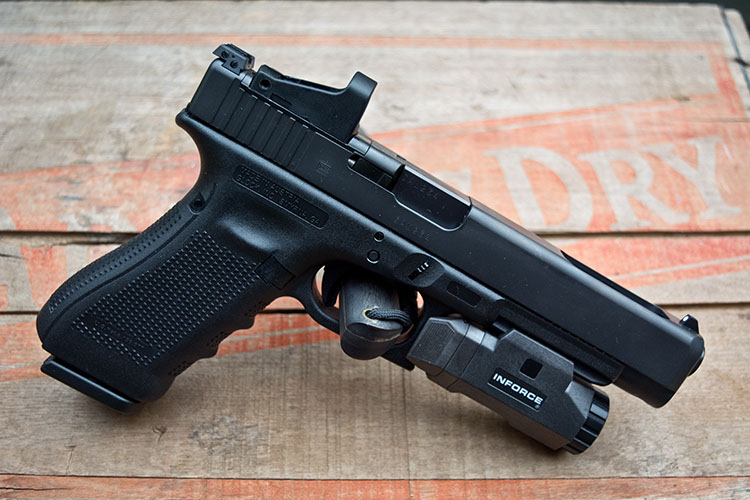
All right, everybody settle down. Optics on pistols isn’t actually new. Back when we were first getting in to shooting, there were already red dots on crazy IPSC race guns; these were generally 1911s in .38 Super. It was an elegant weapon for a more civilized age. And it wasn’t new even then; the first pistol optics were built in the 1960s. We’re not actually old enough to remember those, we just look like it because we’ve been prematurely aged by the writing lifestyle. But the concept always seemed like some kind of half-formed wish. It worked, but the optics were clunky and awkward, and not always especially durable.
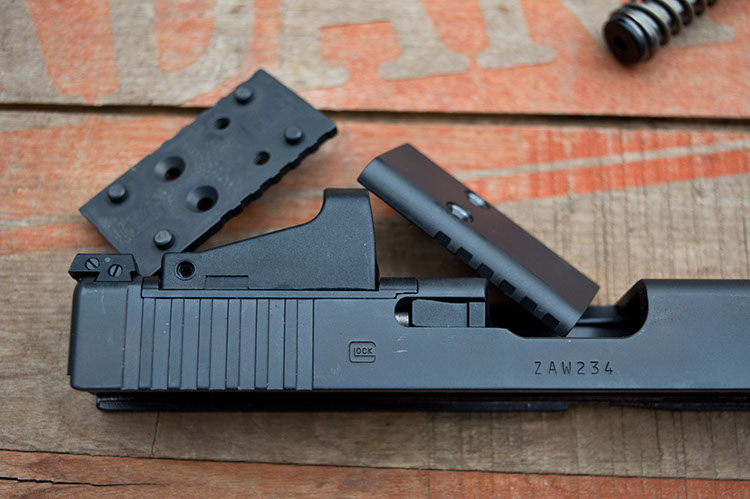
Those days, however, are done. The two biggest names in the law enforcement sidearm business on this continent are both offering optics-ready pistols, and normally-conservative USPSA divisions have been expanded to include Production Optics, making the continued use of these pistols a near-certainty.
Loving as we do the appearance of being on the cutting edge (even when our publisher drives a Land Rover with a million miles on the clock, and our editor constantly tries to make everyone listen to 1980s rock bands), we seized the opportunity to lay our hands on the mighty Glock 34 Modular Optic System, or MOS, to equip it with the original red dot, the Shield Mini-Sight, and to cram it in our brand new Solely Canadian holster and go blasting.
The Glock system uses a series of interchangeable plates to mount optics on the slide. The appropriate plate for the given optic is bolted to the gun with two flush-fitting screws, and the optic affixed over top of these with it’s own screws that thread into the plate directly rather than the slide. This is slightly different than the M&P CORE system, which features seperate plates to mount the optic’s locating pins, but relies on the sights being screwed to the slide. This allows the Glock system to be a bit more versatile, as we found out.
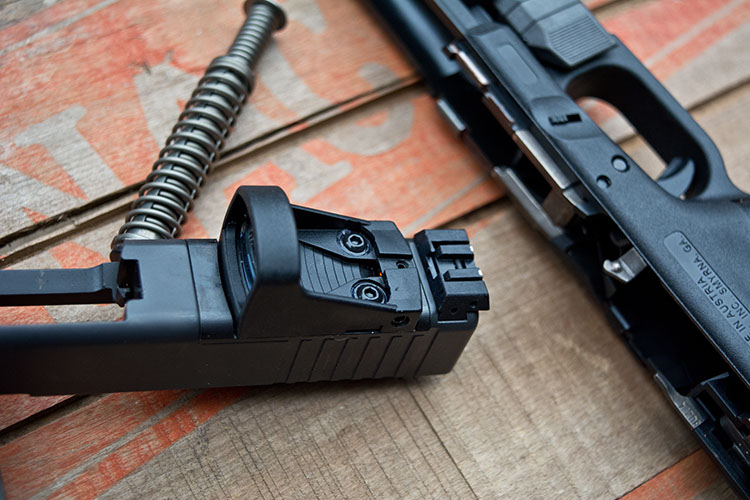
Not very. In fact, as of now, new MOS Glocks will come with five adapter plates instead of four. We obtained an adapter plate directly from Shield PSD, and a couple of screws and a few drops of loctite later, we were in business. The entire operation of mounting the optic takes five minutes, and it’s secure enough to start using the optic as a ledge to rack the pistol off, if you’re wired that way.
Zeroing the red dot is pretty easy. The Mini came with an allen wrench, and we just eyeballed it against the irons, which you can absolutely do, because the Glock MOS and SMS combined makes for a low-enough package that the standard-height (and adjustable) factory Glock irons are perfectly serviceable if the optic dies. However, if you opt for a taller optic like those from Trijicon or a Deltapoint, you will need to replace the iron sights with suppressor-height sights or give up on using your iron sights altogether.
The red dot has reached near-ubiquity status on carbines and is universally regarded as a force multiplier, for reasons that become obvious the moment you begin to shoot with one. There’s no need to line up sights; no need to put a hard focus on the front sight and take in your target as a fuzzy, sometimes double, image. You put the dot where you want the hole, and a hole appears. It’s like magic. So why hasn’t this completely seized the world of handgunning?
While there are a lot of similarities, notably the target focus and single sighting plane, there are also some critical differences. The most immediately noticeable one is this: you need to have a solid kinaesthetic index with your pistol to work fast. It’s not a rifle on which you can just mush your face into the stock and spot the dot. It’s a floppy, lightweight little block of polymer and steel that you’re holding at arms’ length, and it’s very easy to finish your draw pointed a few degrees off target. And if you’re not someone who knows where their front sight is going to be at the end of your press-out, that dot may not be anywhere you can see it. And then you’re hunting for it. Awkward.
The other big difference is that red dots on rifles pretty much stay where you left them. Red dots on pistols, on the other hand, go gallivanting all over town with the rest of your slide on every single shot. Again, not an issue if you have developed the recoil control and muscle memory to bring the gun back on target reliably, but just remember, the red dot on a pistol is not the instant skill upgrade in all conditions that it is on a carbine.
Where the red dot really shines, though, is handling movement at distance. The Glock MOS let us make hits that were inhumanly precise, at any range a sane person would shoot a pistol. The funny thing is, of course, that an MOS Glock isn’t any more accurate than any other Glock 34, and while you don’t have to line up the sights, you still have to have the gun correctly aligned with the target, so it shouldn’t really be any different. But it is. It’s just so easy to shoot for accuracy. You feel like some kind of android. It’s probably approximating what it feels like to be Bob Vogel.
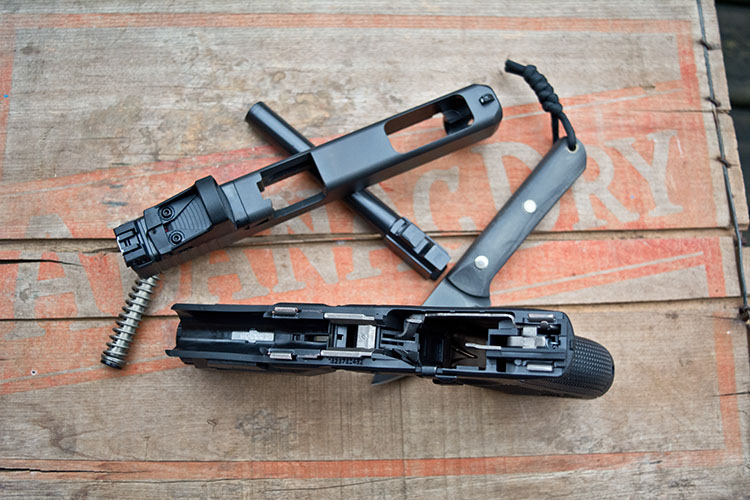 The most effective approach we found to work the MOS was quite similar to our preferred standard pistol draw, which involves a fairly horizontal press out after the pistol is drawn high out of the holster and then brought to a compressed, two-handed grip close to the chest, with the gun pointed on target and the rear sights nearly in line with the clavicle. The only change we made was to make sure we actually drew properly every single time, with no lazy, swooping draws.
The most effective approach we found to work the MOS was quite similar to our preferred standard pistol draw, which involves a fairly horizontal press out after the pistol is drawn high out of the holster and then brought to a compressed, two-handed grip close to the chest, with the gun pointed on target and the rear sights nearly in line with the clavicle. The only change we made was to make sure we actually drew properly every single time, with no lazy, swooping draws.
The reason this fairly strict four-beat draw was so effective is that it allows the shooter to pick up the front sight early in the draw. That’s always going to be a good thing, but we noticed a tendency with some shooters to abandon fundamentals and really “float” the gun around, hunting for that bobbing red dot. That’s slow; don’t do that. The trick, of course, is really to ignore the red dot and look for the front sight and bam: there’s the red dot.
Once you’ve gotten used to acquiring the sight picture, the Glock MOS is a revelation. We’ll admit that there was some skepticism here at Calibre of slide-mounted optics; they’ve never quite lived up to the billing in our experience, and in order to give them a try, you’ve always had to buy a mount, which raised the optic considerably, or have your slide machined, which emptied your wallet considerably.
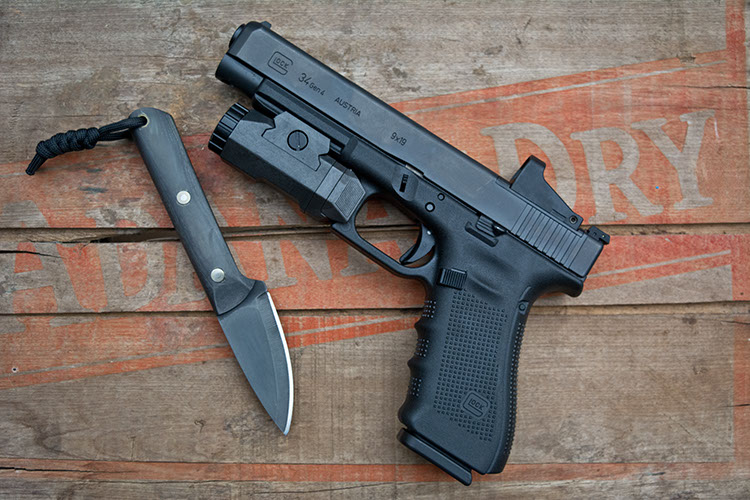 Well, not anymore. The MOS is so slick that we’re ready to go ahead and describe it in tactical jargon: it is a force multiplier. It does take a bit of getting used to but a single training session seemed to be plenty, and then we were on fire. At close range we didn’t feel that we gave up anything that couldn’t be accounted for simply by going to factory sights; at longer ranges the performance was simply phenomenal. The sheer confidence we had on low-probability shots was incredible. We’ll sum it up with this blunt scenario: if we were being held hostage, we would want the rescue team running optics on their handguns. It’s that good.
Well, not anymore. The MOS is so slick that we’re ready to go ahead and describe it in tactical jargon: it is a force multiplier. It does take a bit of getting used to but a single training session seemed to be plenty, and then we were on fire. At close range we didn’t feel that we gave up anything that couldn’t be accounted for simply by going to factory sights; at longer ranges the performance was simply phenomenal. The sheer confidence we had on low-probability shots was incredible. We’ll sum it up with this blunt scenario: if we were being held hostage, we would want the rescue team running optics on their handguns. It’s that good.
So as far as we’re concerned, we’re calling it now. The future is here and it’s factory red-dot capable autos. If you’re invested in the Glock universe, the MOS is a no-brainer... at least, if you can afford one. These are not cheap guns. You’ll need about $1,200 to get one, plus another $370 for an SMS like ours, or even more if you opt for some other sights. But, on the upside, it is a Glock so you know it’ll work for a long, long time. As far as the ultimate reticle for handgunning? 1 MOA dot, 65 MOA ring. Try it. If anything else seems half as good, we need you to write us and tell us the explanation, because as far as we can tell, this is the fastest system on the planet.
The UK-made Shield Mini Sight, or SMS as it’s better known, is a great match to Glock’s G34 MOS. More compact than many of the offerings from Trijicon and other compact red dot manufacturers, it actually was almost exactly the same width as the slide, and is one of (if not the) lightest compact red dot on the market. The combination of its small size and light weight made sure it worked with all our holsters too, unlike some larger optics, which can wear or catch unduly on some holsters with tightly-fitted or especially high sweat guards.
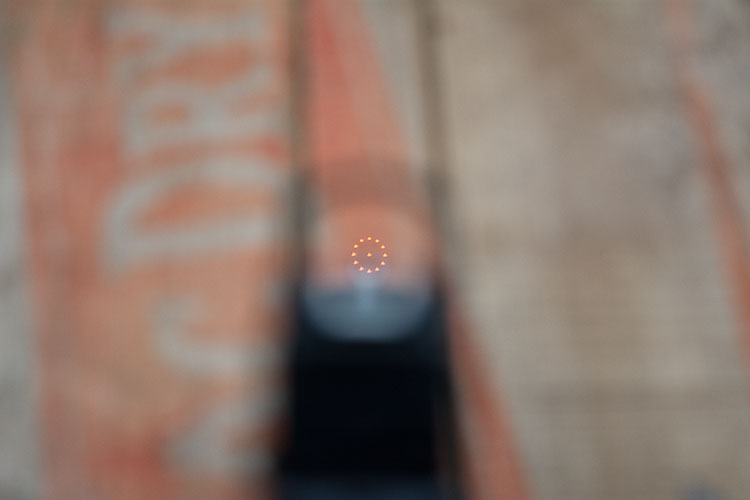 A large factor in the SMS’ light weight is the material from which it is constructed. Like the Glock it’s pictured on, the SMS is made from a lightweight but very strong polymer material, and weighs less than half as much as a Trijicon RMR. Interestingly, even the lens on the SMS is polymer, and according to Shield can withstand up to ten times greater shock impacts than comparable glass-lensed optics due to the polymer lens’ ability to flex rather than crack.
A large factor in the SMS’ light weight is the material from which it is constructed. Like the Glock it’s pictured on, the SMS is made from a lightweight but very strong polymer material, and weighs less than half as much as a Trijicon RMR. Interestingly, even the lens on the SMS is polymer, and according to Shield can withstand up to ten times greater shock impacts than comparable glass-lensed optics due to the polymer lens’ ability to flex rather than crack.
But all these benefits take a back seat to the SMS’ biggest perk: The available reticles. In most cases, compact red dots have one or two options when it comes to reticles; a big dot or a bigger dot. The thinking being than compact red dots are used to acquire targets quickly, and large 4 or 8 MOA red dots naturally attract the eye more easily, isn’t entirely wrong… but Shield has devised a better way to accomplish the same thing with their unique 65 MOA ring, 1 MOA dot reticle. To your eye, the effect is the same as having a 65 MOA dot with a brighter 1 MOA dot in the middle, as your eye easily picks up the giant ring and is naturally drawn into the centre. If you have the time, you can then focus on the 1 MOA centre dot, and score some very accurate hits still since the centre dot doesn’t occlude too much of the target or overwhelm the eye.
So if the SMS is so good, why haven’t you heard of it already? Well, you probably have, except maybe you’ve called it the JPoint, or the Trijicon RedDot. Yes, that’s right, Shield has been manufacturing the SMS under their name for law enforcement and military customers (with over 100,000 delivered), as well as producing them for both JPoint and Trijicon for the US commercial market. So what’ll it cost you? Well, the sights themselves are right around the $370 mark, but budget a few extra dollars for the various mounts and accessories.